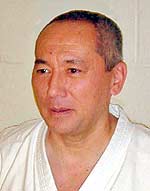Martial Mania
The Class Cork
By George Donahue

In France, the word for “cork” is bouchon. This, of course,
refers to the stopper in a wine bottle. But it’s also used to indicate
a traffic jam, because the flow of traffic is corked up.
Almost every martial arts class or school has a cork. The cork may be
a routine behavior of the instructor that habitually breaks or impedes
the flow of a class. In some small schools, the instructor answers the
phone during class, so as not to miss any inquiry from a potential new
student. That is a definite cork, unless the instructor handles it smoothly.
A cork may be any of a number of other things, including environmental
distractions. For example, I was once a student in a university karate
class that met in the main gym. The first hour of our class was very businesslike,
but then the cheerleaders would arrive for practice right next to our
space. The women cheerleaders at our school were extremely attractive,
in a wholesome way. To the great annoyance of the women in our group,
the males became distracted, inane, and totally incapable of focusing
on anything. For us, men and women, the arrival of the cheerleaders, totally
blameless though they were, was a cork.
Usually, however, the cork is a student in the class. It seems as though
every school has at least one, at least some of the time. A few years
back we had one, a very good-natured guy we nicknamed, for reasons he
never quite understood, “Bouchon.” I’ve always encouraged
students to ask questions, at the appropriate time. Bouchon would stop
up our class by asking unnecessary questions at inappropriate times. Even
if we put off answering, the interruption was often annoying and disruptive
anyway. Or it was funny enough to distract us and we would have to spend
time re-centering ourselves. When a student is a willful cork, then the
instructor has to take him aside and respectfully but firmly set him straight.
But some corks are just stoppers by nature and can never be set straight
for more than the moment, whatever the approach: reason, disciplinary
consequences, ridicule, scorn. Nothing works and you just have to learn
to deal with the occasional clogging of the process.
Having a cork in your class can have a lot of positives, too. Sometimes
the questions or observations of Bouchon would trigger a new way of thinking
about a technique, a new approach to a difficulty. A new explanation.
The best thing, for me, about dealing with corks is that I’ve finally
realized that what keeps us from developing to our full potential as martial
arts students are our internal corks, whether we’re aware of them
or not. These internal corks are a far greater obstacle than any physical
limitations we might have to deal with. We’re all bouchon in one
way or another at one time or another. Once we see that we’re self-corked,
we can figure out how to relieve the blockage, how to expel the detritus.
Then we can improve
About The Author:
George Donahue has been on the board of FightingArts.com
since its inception. He is a freelance writer and editor, providing literary
and consulting services to writers, literary agents, and publishers, as
well to advertising agencies. He has worked in publishing for more than
three decades, beginning as a journal and legal editor. Among his positions
have been editorial stints at Random House; Tuttle Publishing, where he
was the executive editor, martial arts editor, and Asian Studies editor;
and Lyons Press, where he was the senior acquisitions editor and where
he established a martial arts publishing program. He is a 6th dan student
of karate and kobujutsu—as well as Yamane Ryu Bojutsu—of Shinzato
Katsuhiko in Okinawa Karatedo Shorin Ryu Kishaba Juku. He was also a student
of Kishaba Chokei and Nakamura Seigi until their deaths. He teaches Kishaba
Juku in New York and Connecticut, as well as traveling to provide seminars
and special training in karate, weapons, and self-defense. His early training
was in judo and jujutsu, primarily with Ando Shunnosuke in Tokyo. He also
studied kyujutsu (archery), sojutsu (spear), and kenjutsu (swordsmanship)
in Japan as a youth. Following his move to the US, he continued to practice
judo and jujutsu, as well as marksmanship with bow and gun, and began
the study of Matsubayashi Ryu karate in his late teens. Subsequently,
he has studied aikido and taiji and cross trained in ying jow pai kung
fu. |